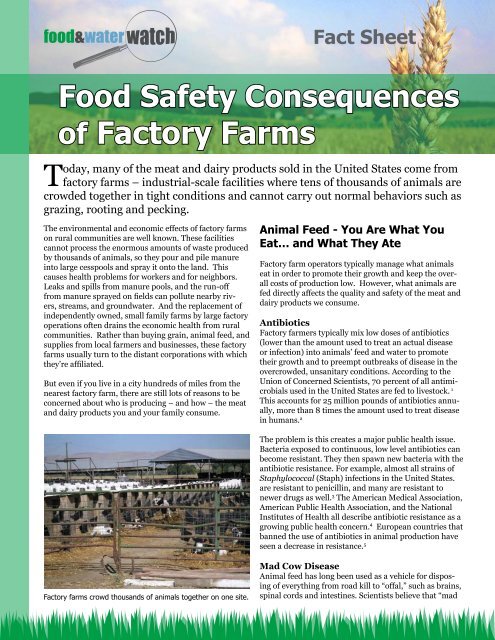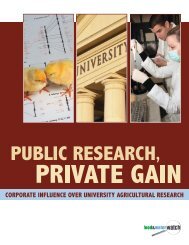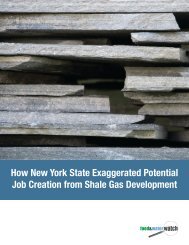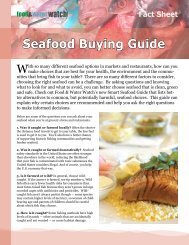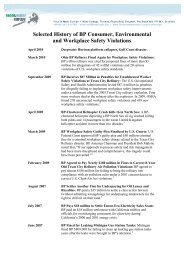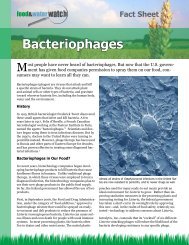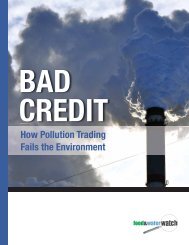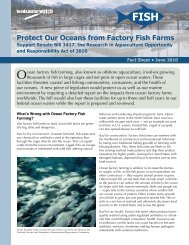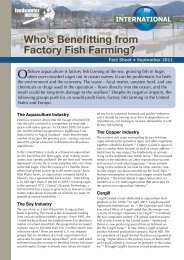Download the PDF file. - Food & Water Watch
Download the PDF file. - Food & Water Watch
Download the PDF file. - Food & Water Watch
Create successful ePaper yourself
Turn your PDF publications into a flip-book with our unique Google optimized e-Paper software.
Fact Sheet<br />
<strong>Food</strong> Safety Consequences<br />
of Factory Farms<br />
Today, many of <strong>the</strong> meat and dairy products sold in <strong>the</strong> United States come from<br />
factory farms – industrial-scale facilities where tens of thousands of animals are<br />
crowded toge<strong>the</strong>r in tight conditions and cannot carry out normal behaviors such as<br />
grazing, rooting and pecking.<br />
The environmental and economic effects of factory farms<br />
on rural communities are well known. These facilities<br />
cannot process <strong>the</strong> enormous amounts of waste produced<br />
by thousands of animals, so <strong>the</strong>y pour and pile manure<br />
into large cesspools and spray it onto <strong>the</strong> land. This<br />
causes health problems for workers and for neighbors.<br />
Leaks and spills from manure pools, and <strong>the</strong> run-off<br />
from manure sprayed on fields can pollute nearby rivers,<br />
streams, and groundwater. And <strong>the</strong> replacement of<br />
independently owned, small family farms by large factory<br />
operations often drains <strong>the</strong> economic health from rural<br />
communities. Ra<strong>the</strong>r than buying grain, animal feed, and<br />
supplies from local farmers and businesses, <strong>the</strong>se factory<br />
farms usually turn to <strong>the</strong> distant corporations with which<br />
<strong>the</strong>y’re affiliated.<br />
But even if you live in a city hundreds of miles from <strong>the</strong><br />
nearest factory farm, <strong>the</strong>re are still lots of reasons to be<br />
concerned about who is producing – and how – <strong>the</strong> meat<br />
and dairy products you and your family consume.<br />
Animal Feed - You Are What You<br />
Eat… and What They Ate<br />
Factory farm operators typically manage what animals<br />
eat in order to promote <strong>the</strong>ir growth and keep <strong>the</strong> overall<br />
costs of production low. However, what animals are<br />
fed directly affects <strong>the</strong> quality and safety of <strong>the</strong> meat and<br />
dairy products we consume.<br />
Antibiotics<br />
Factory farmers typically mix low doses of antibiotics<br />
(lower than <strong>the</strong> amount used to treat an actual disease<br />
or infection) into animals’ feed and water to promote<br />
<strong>the</strong>ir growth and to preempt outbreaks of disease in <strong>the</strong><br />
overcrowded, unsanitary conditions. According to <strong>the</strong><br />
Union of Concerned Scientists, 70 percent of all antimicrobials<br />
used in <strong>the</strong> United States are fed to livestock. 1<br />
This accounts for 25 million pounds of antibiotics annually,<br />
more than 8 times <strong>the</strong> amount used to treat disease<br />
in humans. 2<br />
The problem is this creates a major public health issue.<br />
Bacteria exposed to continuous, low level antibiotics can<br />
become resistant. They <strong>the</strong>n spawn new bacteria with <strong>the</strong><br />
antibiotic resistance. For example, almost all strains of<br />
Staphylococcal (Staph) infections in <strong>the</strong> United States.<br />
are resistant to penicillin, and many are resistant to<br />
newer drugs as well. 3 The American Medical Association,<br />
American Public Health Association, and <strong>the</strong> National<br />
Institutes of Health all describe antibiotic resistance as a<br />
growing public health concern. 4 European countries that<br />
banned <strong>the</strong> use of antibiotics in animal production have<br />
seen a decrease in resistance. 5<br />
Factory farms crowd thousands of animals toge<strong>the</strong>r on one site.<br />
Mad Cow Disease<br />
Animal feed has long been used as a vehicle for disposing<br />
of everything from road kill to “offal,” such as brains,<br />
spinal cords and intestines. Scientists believe that “mad
cow disease,” or Bovine Spongiform Encephalopathy<br />
(BSE), is spread when cattle eat nervous system tissues,<br />
such as <strong>the</strong> brain and spinal cord, of o<strong>the</strong>r infected<br />
animals. People who eat such tissue can contract variant<br />
Creutzfeldt-Jakob disease (vCJD), which causes dementia<br />
and, ultimately, death. Keeping mad cow disease out of<br />
<strong>the</strong> food supply is particularly important because, unlike<br />
most o<strong>the</strong>r foodborne illnesses, consumers cannot protect<br />
<strong>the</strong>mselves by cooking <strong>the</strong> meat or by any o<strong>the</strong>r type of<br />
disinfection. The United States has identified three cases<br />
of mad cow disease in cattle since December 2003.<br />
In 1997, <strong>the</strong> <strong>Food</strong> and Drug Administration (FDA), <strong>the</strong><br />
agency that regulates animal feed, instituted a “feed ban”<br />
to prevent <strong>the</strong> spread of <strong>the</strong> disease. Although this ban<br />
provides some protections for consumers, it still allows<br />
risky practices. For example, factory farm operators still<br />
feed “poultry litter” to cattle. Unfortunately, poultry litter,<br />
<strong>the</strong> waste found on <strong>the</strong> floors of poultry barns, may<br />
contain cattle protein because regulations allow for feeding<br />
cattle tissue to poultry. And cattle blood can be fed<br />
to calves in milk replacer – <strong>the</strong> formula that most calves<br />
receive instead of <strong>the</strong>ir mo<strong>the</strong>r’s milk. Finally, food processing<br />
and restaurant “plate waste,” which could contain<br />
cattle tissue, can still be fed to cattle.<br />
In 2004, after <strong>the</strong> discovery of BSE in <strong>the</strong> United States,<br />
<strong>the</strong> FDA had <strong>the</strong> opportunity to ban <strong>the</strong>se potential<br />
sources of <strong>the</strong> disease from cattle feed. But instead, officials<br />
proposed a weaker set of rules that restricted some<br />
tissues from older cattle. A safer policy for consumers<br />
would be to remove all tissues from all cattle from <strong>the</strong><br />
animal feed system, regardless of <strong>the</strong>ir age, and also to<br />
ban plate waste, cattle blood and poultry litter.<br />
In <strong>the</strong> fall of 2006, <strong>the</strong> U.S. Department of Agriculture<br />
(USDA) decided to scale back testing for mad cow disease.<br />
Officials cited what <strong>the</strong>y claimed was <strong>the</strong> low level<br />
of detection for <strong>the</strong> disease in <strong>the</strong> United States. Now,<br />
Ano<strong>the</strong>r major ingredient for factory farm animal feed is soy<br />
beans.<br />
only 40,000 cattle, one-tenth <strong>the</strong> number tested <strong>the</strong> year<br />
before, will be tested annually. Given <strong>the</strong> weakness of<br />
<strong>the</strong> rules that are supposed to prevent <strong>the</strong> spread of <strong>the</strong><br />
disease, this limited testing program effectively leaves<br />
consumers unprotected.<br />
E. Coli<br />
Cattle and o<strong>the</strong>r ruminants (animals with hooves) are<br />
uniquely suited to eat grass. However, in factory farm<br />
feedlots, <strong>the</strong>y eat mostly corn and soybeans for <strong>the</strong> last<br />
few months of <strong>the</strong>ir lives. These starchy grains increase<br />
<strong>the</strong>ir growth rate and make <strong>the</strong>ir meat more tender – a<br />
process called “finishing.” However, scientists point to<br />
human health risks associated with <strong>the</strong> grain-based diet<br />
of “modern” cattle.<br />
A researcher from Cornell University found that cattle fed<br />
hay for <strong>the</strong> five days before slaughter had dramatically<br />
lower levels of acid-resistant E. coli bacteria in <strong>the</strong>ir feces<br />
than cattle fed corn or soybeans. E. coli live in cattle’s<br />
intestinal tract, so feces that escapes during slaughter can<br />
lead to <strong>the</strong> bacteria contaminating <strong>the</strong> meat. 6<br />
Vegetables can be also be contaminated by E. coli if manure<br />
is used to fertilize crops without composting it first,<br />
or if water used to irrigate or clean <strong>the</strong> crops contains<br />
animal waste. The 2006 case of E. coli-contaminated<br />
spinach offers a dramatic example of how animal waste<br />
can impact vegetables.<br />
Corn is a major ingredient of animal feed on factory farms.<br />
Fat<br />
According to a study by <strong>the</strong> Union of Concerned Scientists,<br />
beef and milk produced from cattle raised entirely<br />
on pasture (where <strong>the</strong>y ate only grass) have higher levels<br />
of beneficial fats, including omega-3 fatty acids, which<br />
may prevent heart disease and streng<strong>the</strong>n <strong>the</strong> immune<br />
system. The study also found that meat from grass-fed<br />
cattle was lower in total fat than meat from feedlot-raised<br />
cattle. 7
Promoting Growth at Any Cost<br />
Factory farms strive to increase <strong>the</strong> number of animals<br />
<strong>the</strong>y raise every year. To do so, however, <strong>the</strong>y use some<br />
practices that present health concerns for consumers.<br />
Hormones<br />
With <strong>the</strong> approval of <strong>the</strong> FDA and USDA, factory farms<br />
in <strong>the</strong> United States use hormones (and antibiotics, as<br />
discussed earlier) to promote growth and milk production<br />
in beef and dairy cattle, respectively. Regulations do<br />
prohibit <strong>the</strong> use of hormones in pigs and poultry. Unfortunately,<br />
this restriction doesn’t apply to antibiotic use in<br />
<strong>the</strong>se animals.<br />
An estimated two-thirds of all U.S. cattle raised for<br />
slaughter are injected with growth hormones. 8 Six different<br />
hormones are used on beef cattle, three of which<br />
occur naturally, and three of which are syn<strong>the</strong>tic. 9 Beef<br />
hormones have been banned in <strong>the</strong> European Union<br />
since <strong>the</strong> 1980’s. The European Commission appointed<br />
a committee to study <strong>the</strong>ir safety for humans. Its 1999<br />
report found that residues in meat from injected animals<br />
could affect <strong>the</strong> hormonal balance of humans, causing<br />
reproductive issues and breast, prostate or colon cancer.<br />
The European Union has prohibited <strong>the</strong> import of all beef<br />
treated with hormones, which means it does not accept<br />
any U.S. beef. 10<br />
Recombinant bovine growth hormone (rBGH) is a genetically<br />
engineered, artificial growth hormone injected into<br />
dairy cattle to increase <strong>the</strong>ir milk production by anywhere<br />
from 8 to 17 percent. 11 The FDA approved rBGH in<br />
1993, based solely on an unpublished study submitted by<br />
Monsanto. 12 Canada, Australia, Japan and <strong>the</strong> European<br />
Union all have prohibited <strong>the</strong> use of rBGH.<br />
Approximately 22 percent of all dairy cows in <strong>the</strong> United<br />
States. are injected with <strong>the</strong> hormone, but 54 percent of<br />
large herds (500 animals or more), such as those found<br />
on factory farms, use rBGH. 13 Its use has increased bacterial<br />
udder infections in cows by 25 percent, <strong>the</strong>reby increasing<br />
<strong>the</strong> need for antibiotics to treat <strong>the</strong> infections. 14<br />
In addition, <strong>the</strong> milk from cows injected with rBGH has<br />
higher levels of ano<strong>the</strong>r hormone called Insulin Growth<br />
Factor-1 (IGF-1). Elevated levels of IGF-1 in humans have<br />
been linked to colon and breast cancer. 15 Researchers<br />
believe <strong>the</strong>re may be an association between <strong>the</strong> increase<br />
in twin births over <strong>the</strong> past 30 years and elevated levels of<br />
IGF-1 in humans. 16<br />
Unwholesome, Unsanitary and<br />
Inhumane Conditions<br />
Raising animals on cramped, filthy and inhumane factory<br />
farms differs greatly from what most consumers envision<br />
as <strong>the</strong> traditional American farm.<br />
Animal waste at factory farms is stored in vast lagoons that can<br />
contaminate local water and air.<br />
Disease<br />
Hundreds of thousands of birds are breathing, urinating<br />
and defecating in <strong>the</strong> close quarters of factory-style<br />
poultry farms. These conditions give viruses and bacteria<br />
limitless opportunities to mutate and spread. This is a<br />
very real concern given <strong>the</strong> presence of avian flu in many<br />
parts of <strong>the</strong> world. The poultry industry has tried to portray<br />
factory farms as a solution to <strong>the</strong> spread of avian flu.<br />
It claims that keeping <strong>the</strong> birds indoors somehow isolates<br />
<strong>the</strong>m from <strong>the</strong> outside world and <strong>the</strong> disease that lurks<br />
<strong>the</strong>re.<br />
Contrary to <strong>the</strong>se claims, scientists suspect that it was<br />
in poultry factory farms that avian flu mutated from a<br />
relatively harmless virus found in wild birds for centuries<br />
to <strong>the</strong> deadly H5N1 strain of <strong>the</strong> virus that is killing<br />
birds and humans today. 17 In England, <strong>the</strong> virulent H5N1<br />
strain first broke out at <strong>the</strong> country’s largest turkey farm<br />
in early 2007. Theories about <strong>the</strong> source of <strong>the</strong> infection<br />
include rats or flies entering <strong>the</strong> facility from a nearby<br />
poultry processing plant that itself had received a shipment<br />
of infected poultry parts from Hungary. 18 These<br />
large-scale facilities rely on truckloads of feed and supplies<br />
that arrive every day, providing a way for <strong>the</strong> disease<br />
to spread.<br />
Contamination<br />
Raising thousands of animals toge<strong>the</strong>r in crowded conditions<br />
generates lots of manure and urine. For example,<br />
a dairy farm with 2,500 cows produces as much waste<br />
as a city of 411,000 people. 19 Unlike a city, where human<br />
waste ends up at a sewage treatment plant, livestock<br />
waste is not treated, but ra<strong>the</strong>r washes out of <strong>the</strong> confinement<br />
buildings into large cesspools, or lagoons. In<br />
feedlots, open lots where thousands of cattle wait and<br />
fatten up before slaughter, <strong>the</strong> animals often stand in<br />
<strong>the</strong>ir own waste before it is washed away. The cattle often<br />
have some water-splashed manure remaining on <strong>the</strong>ir<br />
hides when <strong>the</strong>y go to slaughter. This presents <strong>the</strong> risk of<br />
contamination of <strong>the</strong> meat from viruses and bacteria.
Animal Welfare<br />
Ra<strong>the</strong>r than grazing in green pastures, animals on factory<br />
farms exist in tight confinement with thousands of o<strong>the</strong>r<br />
animals. They have little chance to express <strong>the</strong>ir natural<br />
behaviors.<br />
Pigs on factory farms are confined in small concrete pens,<br />
without bedding or soil or hay for rooting. The stress of<br />
being deprived of social interaction causes some pigs to<br />
bite <strong>the</strong> tails off of o<strong>the</strong>r pigs. Some factory farm operators<br />
respond by cutting off <strong>the</strong>ir tails.<br />
Chickens stand in cages or indoors in large pens, packed<br />
so tightly toge<strong>the</strong>r that each chicken gets a space about<br />
<strong>the</strong> size of a sheet of paper to itself. The chickens are not<br />
given space to graze and peck at food in <strong>the</strong> barnyard, so<br />
<strong>the</strong>y resort to pecking each o<strong>the</strong>r. Many factory farmers<br />
cut off <strong>the</strong>ir beaks, a painful procedure that makes it difficult<br />
for chickens to eat.<br />
The Trend Continues: From Factory<br />
Farm to Table<br />
Factory farming is but one component of <strong>the</strong> industrial<br />
meat production system. Just as small farms have given<br />
way to factory farms, small meat plants are disappearing<br />
while large corporate operations have grown even<br />
bigger – and faster. While <strong>the</strong>se trends increase production<br />
and profits for <strong>the</strong> industry, <strong>the</strong>y also increase <strong>the</strong><br />
likelihood of food contamination problems. Although <strong>the</strong><br />
government provides inspectors to protect consumers,<br />
<strong>the</strong>ir authority is waning as <strong>the</strong> government gives greater<br />
responsibility to <strong>the</strong> industry to self-regulate.<br />
Consumers Can Say No to Factory<br />
Farms<br />
Vote with Your Dollars<br />
Know where your meat comes from. Refer to <strong>the</strong> Eat Well<br />
Guide to find a farm, store or restaurant near you that offers<br />
sustainably-raised meat and dairy products. http://<br />
www.eatwellguide.org/<br />
Or buy your meat directly from a farmer at a farmers<br />
market. Talking with <strong>the</strong> farmers at a farmers market in<br />
person will give you <strong>the</strong> chance to ask <strong>the</strong>m about <strong>the</strong><br />
conditions on <strong>the</strong>ir farm. You can find farmers markets<br />
at http://www.ams.usda.gov/farmersmarkets/map.htm<br />
and you can find questions to ask a farmer at http://<br />
www.sustainabletable.org/shop/questions<br />
Organic meat is also a good choice, since <strong>the</strong> organic label<br />
means that <strong>the</strong> product has met standards about how <strong>the</strong><br />
meat was produced. Visit our website at www.foodand<br />
waterwatch.org to check out our labeling fact sheet to find<br />
out more about which labels to look for. And check out<br />
our milk tip sheet to find out which milk labels to look for<br />
and our product guide for rBGH-free dairy products in<br />
your area.<br />
Endnotes<br />
1<br />
Union of Concerned Scientists, “Hogging it!: Estimates of Antibiotic<br />
Abuse in Livestock”. UCS, 2001<br />
2<br />
Union of Concerned Scientists. “<strong>Food</strong> and Environment: Antibiotic<br />
Resistance.” UCS, October 2003.<br />
3<br />
Keep Antibiotics Working. “The Health Threat.” www.keepantibioticsworking.com.<br />
4<br />
“Antibiotics and Antimicrobials.” American Medical Association.<br />
http://www.ama-assn.org/ama/pub/category/1863.html.<br />
“The Problem of Antimicrobial Resistance.” National Institute of Allergy<br />
and Infectious Disease. http://www.niaid.nih.gov/factsheets/antimicro.<br />
htm. April 2006<br />
“Antibiotic Resistance Fact Sheet.” American Public Health Association.<br />
http://www.apha.org/advocacy/reports/facts/advocacyfactantibiotic.<br />
htm.<br />
5<br />
McEwen , Scott A. and Fedorka-Cray, Paula J. “Antimicrobial Use<br />
and Resistance in Animals” Clinical Infectious Diseases 34(Suppl 3):<br />
S93–106, 2002.<br />
6<br />
Francisco Diez-Gonzalez, Todd R. Callaway, Menas G. Kizoulis, James<br />
B. Russell. “Grain Feeding and <strong>the</strong> Dissemination of Acid-Resistant<br />
Escherichia coli from Cattle” Science, 281 (5383):1666-1668, September<br />
11, 1998.<br />
7<br />
“Greener Pastures: How grass-fed beef and milk contribute to healthy<br />
eating.” Union of Concerned Scientists, Cambridge, MA, 2006.<br />
8<br />
Raloff, Janet. “Hormones: Here’s <strong>the</strong> Beef: Environmental concerns<br />
reemerge over steroids given to livestock.” Science News 161, (1):10.<br />
January 5, 2002.<br />
9<br />
The Scientific Committee on Veterinary Measures Relating to Public<br />
Health. “Assessment of Potential Risks to Human Health from Hormone<br />
Residues in Bovine Meat and Meat Products.” European Commission,<br />
April 30, 1999.<br />
10<br />
The Scientific Committee on Veterinary Measures Relating to Public<br />
Health. “Assessment of Potential Risks to Human Health from Hormone<br />
Residues in Bovine Meat and Meat Products.” European Commission,<br />
April 30, 1999.<br />
11<br />
Bovine Somatotropin (bST)” Biotechnology Information Series (Bio-3)<br />
North Central Regional Extension Publication Iowa State University<br />
- University Extension, December 1993.<br />
12<br />
Cruzan, Susan M. FDA Press Release on rBST approval. <strong>Food</strong> and<br />
Drug Administration. November 5, 1993.<br />
13<br />
APHIS, “Bovine Somatotropin: Info Sheet” USDA, May 2003.<br />
14<br />
Doohoo I. et al, “Report of <strong>the</strong> Canadian Veterinary Medical Association<br />
Expert Panel on rBST,” (Executive Summary) Health Canada,<br />
November, 1998.<br />
15<br />
Epstein SS. “Unlabeled milk from cows treated with biosyn<strong>the</strong>tic<br />
growth hormones: a case of regulatory abdication.” International Journal<br />
of Health Services, 26(1):173-85, 1996.<br />
16<br />
Steinman G. Can <strong>the</strong> chance of having twins be modified by diet?<br />
Lancet, 367(9521):1461-2, May 6, 2006.<br />
17<br />
“Fowl play: The poultry industry’s central role in <strong>the</strong> bird flu crisis”<br />
GRAIN, February 2006, p.2, website?<br />
18<br />
“Turkey carcasses from Hungary linked to UK bird flu outbreak” The<br />
Observer, 2/8/07, Jo Revill, www.observer.co.uk<br />
19<br />
“Risk Management Evaluation for Concentrated Animal Feeding<br />
Operations,” US Environmental Protection Agency A National Risk<br />
Management Laboratory, May 2004, p. 7.<br />
For more information:<br />
web: www.foodandwaterwatch.org<br />
email: foodandwater@fwwatch.org<br />
phone: (202) 797-6550<br />
Copyright © March 2007 <strong>Food</strong> & <strong>Water</strong> <strong>Watch</strong>


